by Heather Plett | Apr 30, 2013 | Leadership, Wisdom, women
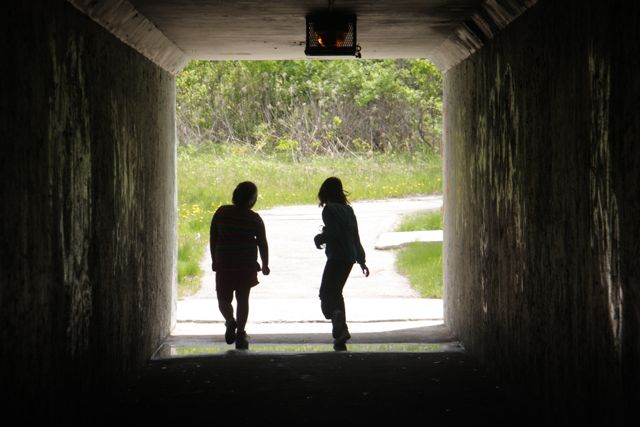 I’m a statistic. I’m one of the women Sheryl Sandburg and others talk about who don’t, in their opinion, help the cause of feminism. I made it all the way to the glass ceiling, peered through the cracks, decided I didn’t like what I saw, and walked out. I’m a “walk out who walked on.”
I’m a statistic. I’m one of the women Sheryl Sandburg and others talk about who don’t, in their opinion, help the cause of feminism. I made it all the way to the glass ceiling, peered through the cracks, decided I didn’t like what I saw, and walked out. I’m a “walk out who walked on.”
There’s a pretty good chance I would have made it through that glass ceiling if I’d “leaned in” long enough. I had all of the credentials and was an ambitious up-and-comer at the time. I took the fast track through the ranks of the public service, had the title “director” added to my name, got the office right next to the corner office, and was making more money than I’d ever dreamed I could.
On top of the career, I had a good feminist husband who carried his share of the household and parenting responsibilities, a couple of beautiful daughters, a house in the suburbs, a minivan, a trailer at the lake, and a boat. You could say I had it all – the feminist’s dream.
And now? I still have the husband and daughters (with an extra one since those days), but I no longer have the trailer at the lake, the boat, the comfortable paycheck or the title of “director” attached to my name. Instead, I have a tiny office in my basement without a window and a fledgling career as a teacher, coach, facilitator and writer.
Some might call me a failed feminist. I let go of the dream that my foremothers fought for. I quit the corporate climb on the wrong side of the glass ceiling. Instead I now spend a good portion of my days creating mandalas with Sharpie markers, hosting story circles, and inviting retreat participants to stitch together quilt squares – not exactly the things a traditional feminist would take pride in.
Why did I walk away from the corporate career and the frequent flyer points in favour of Sharpie markers, quilt squares, and women’s retreats?
There are a few reasons.
- At the height of my career, I had a stillborn son whose presence in my life reminded me that my priorities are not wealth, work, or prestige but rather family, community, and space for spirituality.
- I wanted to find happiness. I knew that the corner office wasn’t my path to happiness.
- I became convinced that it’s time for feminism to grow into something new, and I was pretty sure that I could serve a greater role in helping to birth the new wave of feminism from outside a corporate structure.
It’s that last point that I want to talk about in this article. Instead of a “failed feminist”, I like to think of myself as an “emergent feminist”.
It’s time, I believe, for women to change the world. That won’t happen simply by getting into CEO positions and taking more seats at the boardroom tables. Women will change the world only if we CHANGE LEADERSHIP.
When I was in formal leadership, on my way to the top, I thrived because I learned to think like a man. I listened to the voices of mentors who told me that “feelings have nothing to do with leadership and you should leave them out of the boardroom”, I shut down my intuition in favour of logic, I left my spirituality and much of my creativity at home, I was careful not to be too wild or passionate, and I even started to believe what I was told once that “relationships get in the way of good programming.”
By the time I broke away from formal leadership to start my own business, ten years after being named a director, I was almost completely burnt out from living in a way that was not authentic to me. I returned to the things that made me feel alive – spiritual practices, art-making, wandering in the woods, and relationships – and when I did I realized that THESE THINGS were exactly what had been missing in my leadership practice. More importantly, they weren’t just absent from my own journey, they were missing from leadership in general.
Instead of leaving them at home, I should have clung to them and brought them into my work. Instead of shutting down my feelings and encouraging my staff to do the same, I should have invited them to bring their vulnerability into conversation circles. Instead of creating strategic plans that rarely evoke any imagination, I should have drawn mandalas that wake up the right brain and invite it to the table. Instead of sitting around energy-killing boardroom tables, I should have held staff retreats in the middle of the woods.
For far too long, we’ve accepted a masculine-dominated leadership paradigm in our government offices, our businesses and even our non-profits that is no longer serving us. As Margaret Wheatley and Deborah Frieze say in Walk Out Walk On, we’ve been relying on the leader-as-hero model, when what we really need now is the leader-as-host. In the words of Tina Turner, “we don’t need another hero”. We need people who can lead from a place in the circle, people who can help heal the brokenness in the world, people who help us feel connected again, and people who can remind us of the importance of our relationship with the earth.
“Leadership is about rearranging the chairs, getting the questions right, putting citizens in front of each other and then knowing what’s worth focusing on. The leadership I’m longing for is the leadership that says my number one job is to bring people together, out of exile, out of isolation, and into connection.” – Peter Block
All around us, we see signs of how disconnected we have become – over-consumption of our resources, terrorist attacks, climate change, extreme poverty, etc. These are the stories of a disconnected human race and this disconnection has been fueled by competitive, hierarchical, power-driven leadership that has been allowed to run un-checked.
If the new wave of feminism has a role to play in the world it is not about pushing harder for the corner office, but about bringing us back to a place of connection. Instead of fighting for the top jobs, the power and the prestige, we should be urging our leaders to bring us out of exile and back to community, back to spirituality, back to earth stewardship, and back to ourselves.
Instead of simply fighting to gain entry into the halls of power, we should be working to change the furniture in those halls. It’s time to move the chairs into a circle and open the windows to the world. It’s time to air out the corner office and replace it with conversation spaces. It’s time to replace competitiveness with collaboration, and hierarchy with community.
This is why I decided to walk out and walk on… my role in the world is no longer to fight for power, it’s to help us figure out how to balance power with love. Instead of standing in front of people, I’m sitting beside them and creating space for conversations. Instead of thinking like a man, I’m inviting men to think more like women.
I don’t want the corner office, but that doesn’t mean I don’t want to see a woman there. I will always fight for her right to be there, and when she gets there, I’ll be standing beside her, helping her to take down the walls of her corner office and invite people in. I will urge her to see the world through balanced eyes, honouring both the feminine and the masculine in the world, and creating space for us all to have meaningful conversations that lead the world into the transformation it needs.
I’m now leading from a place in the circle so that I can help other women (and men) learn to do the same. When we’ve gathered into that circle, we can all lean in and listen to each other.
If you’re looking for a new way of defining leadership, join me on a free call on Re-imagining Leadership for our Time on May 1 at 2 pm. Central.
by Heather Plett | Apr 23, 2013 | Leadership, Uncategorized
“I’m finally beginning to realize that I’m a leader.”
Those are the words I heard not long ago from a woman who’d just finished the four month leadership program I was co-facilitating. She was an incredible woman doing great things in her community, including lobbying to save a local nature trail, but she’d never thought of herself as a leader.
I hear those words all the time, especially from women. I’ve been hearing them recently in relation to my online course Lead with Your Wild Heart. “I love your program… but… I’m not sure I’m a leader.” Almost without fail, these women are gifted in art, teaching, community transformation, homemaking, earth stewardship, etc., and yet they don’t see leadership in what they do.
Part of the purpose of Lead with Your Wild Heart is to re-imagine leadership for our time. I believe that the need in the world has changed and that we now need to see leadership through a new lens.
I believe that the leaders the world needs now are those who know how to host conversations, imagine change, paint, dance, sing, write poetry, love generously, live in right relationship with the earth, build community, imagine new ways of using and honouring our limited resources, teach, and play.
As Margaret Wheatley says, a leader is “anyone who is willing to help.” The world needs us to show up and help right now, with whatever gifts we have to offer.
I’ll be hosting a free call on Wednesday, May 1st, at 2 p.m. Central on Re-Imagining Leadership for Our Time.
The call will be an exploration into a new way of defining leadership that fits the paradigm we are now living in. Your questions and ideas on the subject will be more than welcome. One of my deepest beliefs about effective leadership is that it involves hosting meaningful conversations that help surface the wisdom in the circle. Your wisdom is welcome in this circle, and so are your doubts, questions, and curiosity.
I’m happy to be joined in the call by some of the members of my Wise Heart Wisdom Circle. Those who’ve confirmed so far are Desiree Adaway, Julie Daley, and Lisa Wilson.
Sign up below and you’ll receive the call information in your inbox. I look forward to our conversation!
ALSO… over on Facebook, I’m collecting “what if” questions about leadership to inspire us for the conversation. Scroll down below the sign-up form to see the ones already gathered, and add your own to the comments of this post.

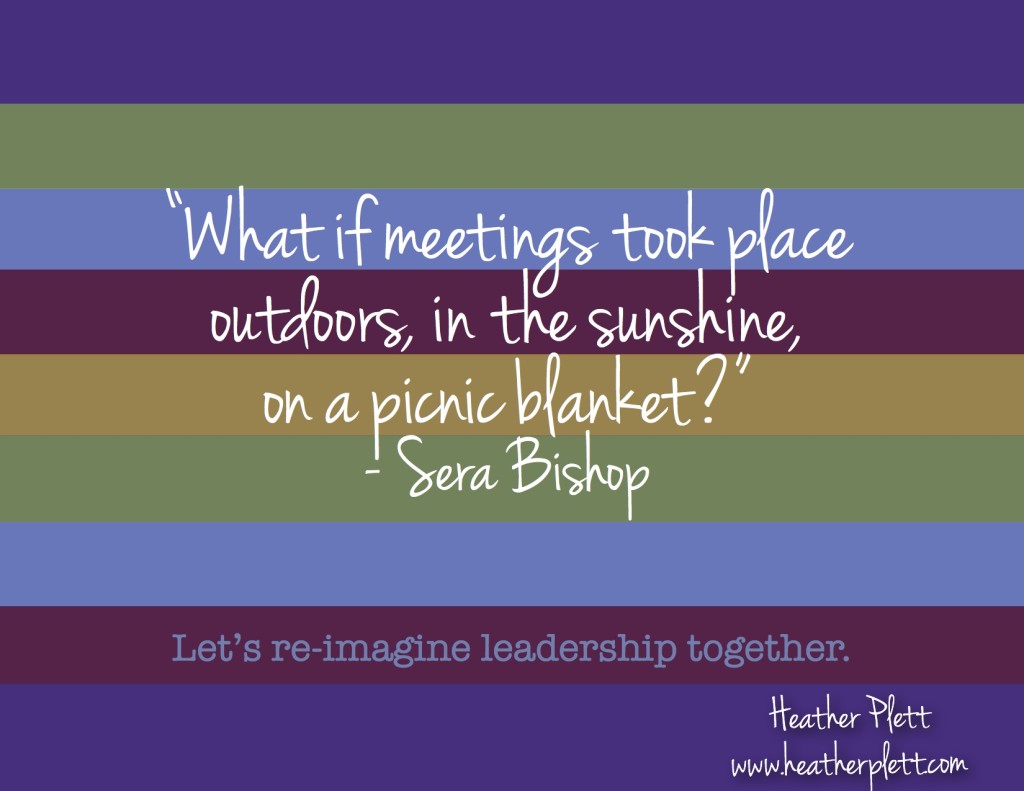
by Heather Plett | Feb 20, 2013 | Beauty, grief, hope, Uncategorized
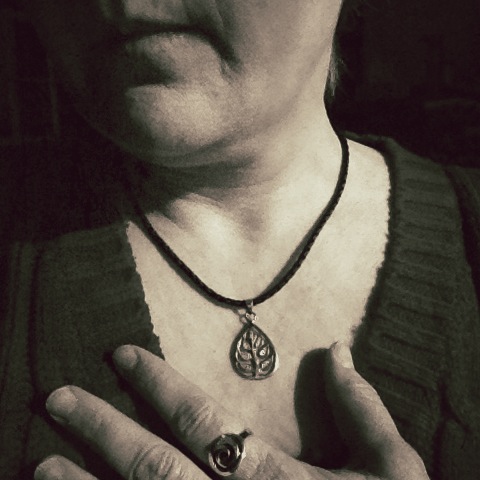
I wanted to find hope again. I really, REALLY longed for it.
I wanted to have some hint of what it will be like when I no longer feel buried under the grief of Mom’s death and the added trauma of Marcel’s heart attack and the accompanying financial stress, extra workload on my shoulders, etc., etc.
I know that “this too shall pass”. It’s what I cling to every time I find myself spiralling down into the hard places in life. “I’ve been through this before. I know that I can survive. It will get better.”
When I found the necklace in Ten Thousand Villages, I knew that I’d found my symbol of hope. It’s a tree of life, crafted by artisans in Cambodia out of the shell casings of bombs that litter the countryside. Perfect. Creating something beautiful out of destruction, loss, and grief. Making the land safe again by cleaning up the unexploded land mines and making them into jewellery. Hope out of hardship. Sounds pretty close to what I specialize in.
“…and they shall beat their swords into plowshares, and their spears into pruning hooks: nation shall not lift up sword against nation, neither shall they learn war any more.” (Isaiah 2:4)
I texted Marcel a photo of the necklace. “Don’t you want to buy me something for Valentine’s Day?” I asked. Sure enough, he did. He was in the store later that day and the necklace was mine. I was delighted.
Not only was it a little bit of hope to wrap around my weary neck, it felt like a new trademark for the work I do with clients. “You too can find beauty in the grief and destruction of your lives. You can rise out of the brokenness and be courageous, resilient, and authentic. You can find deeper connection and more honest stories when you clean up the land mines and turn them into necklaces.”
And then, two days later, the necklace was gone. I stood in the bookstore bathroom, looking down at the chain on the floor. There was no tree of hope attached anymore. Somehow, somewhere, it had slipped off my neck.
I searched everywhere, but it was nowhere to be found.
Instead of holding my head up high and telling myself it was “just a necklace,” I took a nosedive into self-pity and hopelessness. “What the hell, universe? Do you hate me? Do you really want to take away the one thing that was giving me a bit of hope in all of this hardship?”
It was on my dad’s birthday that I lost my necklace. He would have been 79. Right there in that bookstore washroom (where I returned after retracing my steps throughout the store and into the parking lot), I sat and wept for all of the losses and grief stories in my life. The necklace was just the symbol (and the proverbial straw that broke this camel’s back) of everything else that has been lost in the last dozen years – my dad, my mom, my son, nearly my husband (twice)… and so many more, smaller losses. I wept and wept and let myself feel the weight of all of that grief.
And then the next morning, on my way to work, I had a car accident. Yes, really.
It was a minor car accident and nobody was hurt and there is only very minor damage to my car, but it felt like my whole world had fallen apart.
I sat in my office and cried some more. And raged at God. And cried some more. And raged. And cried. And then I got up, and moved my body a little, said a little prayer of gratitude that I hadn’t been hurt… And then… somehow… I carried on. I finished preparing for the workshop I had to deliver yesterday and then went out to the rural town where I was delivering it. I sat in circle with the women in the leadership program I’m co-hosting, and I let the conversation and the compassion in the room offer me a little bit of healing.
When I got home late last night, Marcel met me at the door holding a tiny silk package. Inside was another tree of hope necklace. He’d gone back the the store, told them about the clasp that had come undone, and they replaced it.
And now I’m wearing hope around my weary neck again – a neck made newly stiff from a slight case of whiplash, but a neck that is resilient and strong and will continue to hold my head up high when it needs to, and let it fall to my hands in tears when that’s what needs to happen.
I don’t have a neat little bow to tie this post up with. Life hasn’t become magically easy, and I still feel a little shaky and weepy, but this morning I am reminded that the real hope comes not from anything I can buy or wear. The real hope comes from the relationships that support me – my husband who cares enough to replace the necklace (and so much more), strangers at the store who were compassionate enough to believe him, the women in the circle who let me be authentic in their presence, my co-worker who let me be a little more broken apart than usual yesterday, the woman in the accident who thanked me for my courage in standing up to the man who caused the accident but refused to take personal responsibility, my friends who sent kind messages… and God, the source of my strength, who doesn’t promise ease, but promises courage if I dare to trust.
If another tragedy happens tomorrow, I might fall apart again, I might rage and scream and wallow in self-pity, but then I will get up off the floor and continue to make swords into plowshares. Because hope is still worth striving for. And love is still better than war. And light is still better than darkness.
And the tree of life grows best in the compost of the fallen trees of years past.
by Heather Plett | Feb 6, 2013 | change, circle, Creativity, Leadership, women
I have the great privilege these days of co-hosting a women’s leadership program that meets every second week in a small town an hour and a half from the city where I live. There are so many things about this that I love, including the fact that I have a regular reason to drive out into the country and see the wide open prairies and the wild, alluring woods. With no parents left to visit, I don’t get out to my rural roots often enough to suit me.
On the drive out there yesterday, we had a rare and wonderful sighting of a lynx as it dashed across the road and ran off into the snowy woods. It felt like a moment of blessing.
Yesterday’s session focused on facilitating change. The best change process I know of is Theory U, a process I was first immersed in at ALIA Summer Institute and that I’ve been a dedicated student of since.
I introduced the idea of a Change Lab, where-in we would walk through the U process by casting ourselves in the role of community leaders who recognize the need for change in how the community is organized.
I started out by sharing the story of Baba Yaga’s House in Paris, France, a home created for aging feminists by a circle of women who realized that none of the available models for seniors’ housing fit with their values or expectations of how they wanted to live. (I encourage you to listen to the podcast at the link above.) “Imagine we are these women,” I said. “We are faced with an established community model we know doesn’t work for us, and yet we haven’t found a new model that we’re comfortable with.”
From there I moved on to an explanation of Theory U, a method for co-creating social change. Instead of trying to find a direct route from challenge to solution – the way some of the more linear models do, with brainstorming, strategic planning, etc. – Theory U takes us on a deep dive into the unknown. Instead of trying to direct change, we host what is wanting to be born. Instead of trying to control, we let go and let come. Instead of expecting the future to look like the past with just a few tweaks, we invite a new future to spiral up out of the brokenness of the past.
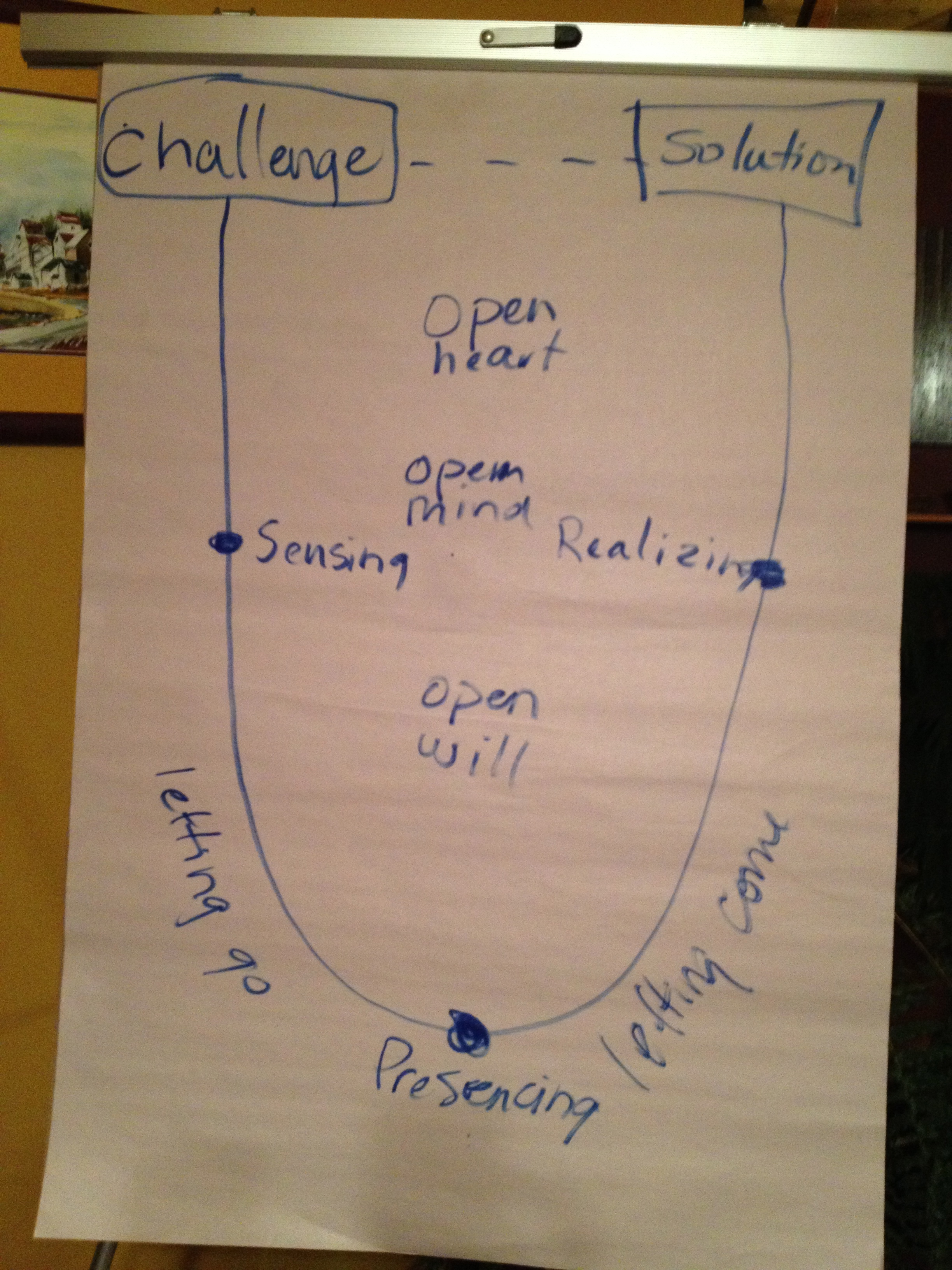 In Theory U there are three main parts – sensing, presencing and realizing. In the sensing phase, we are invited to use all of our senses to witness what is present. We are invited to suspend our judgements, opinions, assumptions and mental models, and to use our eyes and ears and the feeling of our bodies to sense into whatever the context is. We host conversations, we ask good questions, we listen deeply, we watch with full attention, and we notice how our bodies feel.
In Theory U there are three main parts – sensing, presencing and realizing. In the sensing phase, we are invited to use all of our senses to witness what is present. We are invited to suspend our judgements, opinions, assumptions and mental models, and to use our eyes and ears and the feeling of our bodies to sense into whatever the context is. We host conversations, we ask good questions, we listen deeply, we watch with full attention, and we notice how our bodies feel.
In the presencing phase, we are invited into the inner work of grounding ourselves in our bodies and paying attention to what is emerging. We listen into the space and learn from the future as it emerges, letting go of our expertise and experience. Rather than moving directly into problem solving or brainstorming, we take time for retreat and reflection. The best place for presencing is outside in nature where we ground ourselves in the earth and lean into the trees.
The third phase is Realizing. In this phase – on the upward movement out of the U – we “let come” what wants to emerge. We bring insights, sparks of inspiration, and crystals of ideas into prototypes. We move into action quickly and create small projects that can move the vision forward.
When I introduced Theory U to a women’s circle in Ontario last year, someone pointed out that I’d just drawn a woman’s breast. She said it with laughter, but when we started to unpack that, we realize that there was resonant truth to what she witnessed. This process definitely has a feminine aspect to it (as is laid out in this article by Arawana Hayashi) and it relates well to an infant suckling at the source of his/her life. It’s about going back to Source, it’s about seeking nurturing and rebirth, and it’s about the kind of rest and retreat that a mother must seek every few hours when an infant needs to suckle. It’s about being innocent, vulnerable, uneducated, without judgement, and open to a new future, just like that tiny baby. Since that first observation, I’ve brought up the idea every time I introduce it, and it always opens up interesting dialogue.
Once I had introduced the Theory, it was time to move into practice. To start with, I did one of my favourite things to do in workshops – I dumped a pile of garbage on the floor (things I’d gathered from my household recycling bin). “This,” I said, “represents the chaos and brokenness of the systems that no longer work for us. Out of this, something new wants to emerge, but we don’t yet know what it is. It will be up to us to host that new thing into being, without relying on what was or casting judgement on the ‘way it’s supposed to be’.”
In the Sensing phase, I asked them to sit in one-on-one conversations with a few different people in the room. “Ask deep questions, explore what is present, and use your senses to witness what is. Suspend judgement and don’t rely on past or second-hand information.”
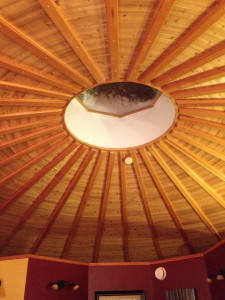 After a few rounds of conversation (too short, but all the time we had), they were invited to move into Presencing. “If it weren’t a cold winter night outside,” I said, “I’d encourage you to move outside for this part. Instead, find a quiet place inside where you can be alone with your thoughts and with whatever wants to emerge.” (As an aside, it felt beautifully appropriate that we were gathered inside a mandala home, a circular home built with great intention around honouring the four directions, giving space at the centre, and blending into the beauty of nature that surrounds it.)
After a few rounds of conversation (too short, but all the time we had), they were invited to move into Presencing. “If it weren’t a cold winter night outside,” I said, “I’d encourage you to move outside for this part. Instead, find a quiet place inside where you can be alone with your thoughts and with whatever wants to emerge.” (As an aside, it felt beautifully appropriate that we were gathered inside a mandala home, a circular home built with great intention around honouring the four directions, giving space at the centre, and blending into the beauty of nature that surrounds it.)
The next phase brought them back to the garbage on the floor, where they began to explore what wanted to emerge. Some felt stuck and really didn’t connect right away with the garbage on the floor. Others were eager to jump in and host the emerging future. Before long, though, everyone had made a valuable contribution to the scale model of the new community that wanted to be born.
We spread our community out on a large piece of cardboard on the table. Some pieces represented a connection with nature, others represented a connection with our neighbours, others represented a connection with opportunities/arts/beauty/etc., and still others represented a deeper connection with self and the sacred.
When we sat discussing the panorama in front of us, we realized that the resounding theme of what was emerging was connection. We were all longing for connection – with each other, with the earth, with the water, with the Sacred, and with ourselves.
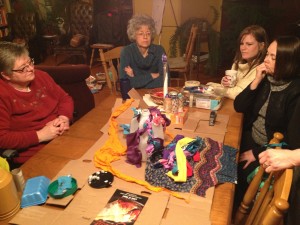 One woman asked “If recycling is the bi-product of a culture of consumption, what can replace consumption as our dominant paradigm that will no longer have a requirement for recycling?” Connection, we agreed. We need deeper connection.
One woman asked “If recycling is the bi-product of a culture of consumption, what can replace consumption as our dominant paradigm that will no longer have a requirement for recycling?” Connection, we agreed. We need deeper connection.
Before we departed for the night, I invited the women to consider (in their private moments, when they were back in their homes) “How might each of us be ambassadors for connection in our communities? How might we begin to invite this future into the circles in which we live?”
The women left with new lights in their eyes that hadn’t been there when they’d entered the room – all because of a pile of garbage and a time of connection.
(Next week’s session flows beautifully out of this… We’ll be talking about making connections in women’s leadership circles, using the new toolkit created by my teachers Christina Baldwin, Ann Linnea, and Margaret Wheatley.)
Note: If you want more inspiration on this, visit Presencing Institute, read Theory U, Presencing, or Walk Out Walk On.
by Heather Plett | Jan 23, 2013 | circle
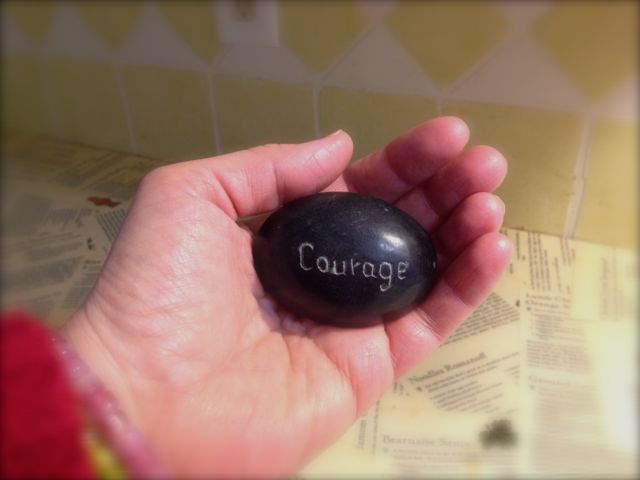
I’ve taken on the delightful task of co-hosting a women’s leadership learning circle that meets every second Tuesday in a rural community in our province. Yesterday’s circle focused on conflict resolution and difficult conversations.
We started the evening making collages that represented the things that we want to breathe out (release/stop doing) and breathe in (receive/embrace/learn) in relation to conflict in our lives. From there we moved into personal assessments of how we each respond to conflict. We talked about how each conflict is shaped by our level of commitment to the relationship and to the agenda at stake, and how we choose our conflict styles accordingly. The sharing in the circle was, as always, personal and intimate. There were stories of conflict in our workplaces, conflict in our marriages and family relationships, and conflict within ourselves.
At the end of the workshop, we asked the women to share what they had breathed in (received) and what they had been able to breathe out (release) throughout the course of the workshop. As they shared, we passed around a talking piece – the courage stone that was a gift from my friend Jo-Anne.
When the stone had completed the circle and returned to me, I said “it is always a pleasure to hold this stone after it has been in the hands of each of you in the circle. As it passes around the circle, it picks up energy from each of you, and that energy changes the rock. The colour becomes richer, and by the time it gets back to me, it is much warmer than it was when I first pulled it out of my bag. You have each given a piece of your energy to this circle and to this stone.”
Women’s circles are always the same. We bring little bits of courage, little bits of fear, little pieces of our stories, and little bits of our love. We pour it all into the container of the circle, we hold the edge for each other, and our offerings lend each of us a little bit more energy and courage than we put in.
It’s like a soup for which we each brought an ingredient. You may have only brought the carrots, but once the soup is done, once we’ve each had a chance to add our ingredients, we each have enough for a nourishing meal.
As we pass our stories around the circle, our courage grows and we all leave changed by the time we spent together.
 I’m a statistic. I’m one of the women Sheryl Sandburg and others talk about who don’t, in their opinion, help the cause of feminism. I made it all the way to the glass ceiling, peered through the cracks, decided I didn’t like what I saw, and walked out. I’m a “walk out who walked on.”
I’m a statistic. I’m one of the women Sheryl Sandburg and others talk about who don’t, in their opinion, help the cause of feminism. I made it all the way to the glass ceiling, peered through the cracks, decided I didn’t like what I saw, and walked out. I’m a “walk out who walked on.”






